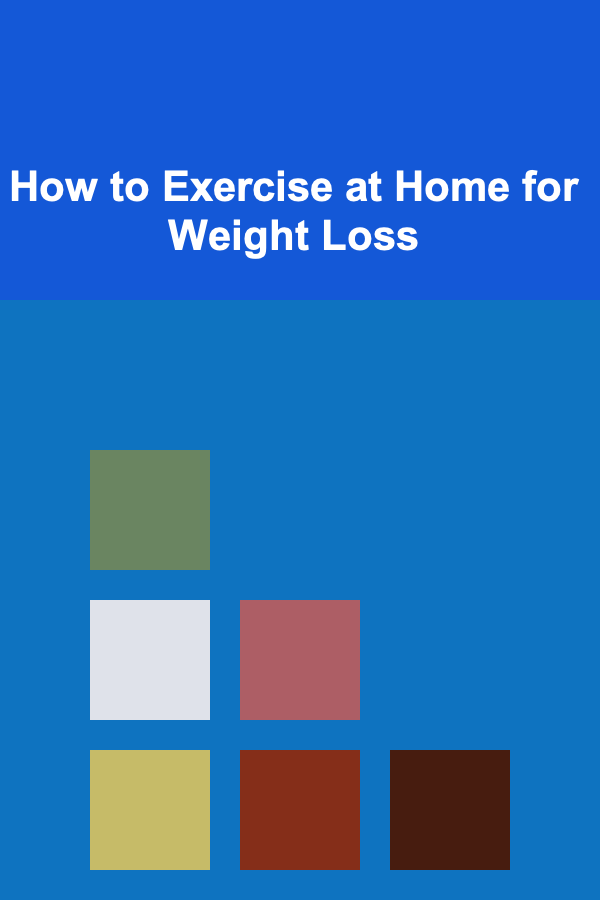
How to Exercise at Home for Weight Loss
ebook include PDF & Audio bundle (Micro Guide)
$12.99$6.99
Limited Time Offer! Order within the next:

Losing weight is a journey that requires commitment, consistency, and knowledge about the most effective ways to achieve a sustainable, healthy lifestyle. Exercise is an essential component of any weight loss plan, but you don't always need a gym membership or fancy equipment to shed pounds. Exercising at home can be just as effective if approached with the right mindset and plan. This article will explore how to exercise at home for weight loss, covering various types of exercises, their benefits, and how to create a personalized home workout routine that suits your needs.
The Science Behind Weight Loss
Before diving into specific exercises, it's important to understand the basic principle of weight loss: caloric deficit. Weight loss occurs when the number of calories burned through physical activity and body functions exceeds the number of calories consumed through food and beverages. The body then starts using stored fat as energy, resulting in weight loss.
Exercise plays a key role in helping to create and maintain this caloric deficit. It boosts the number of calories you burn and improves your metabolism, leading to more efficient fat burning. In addition to burning calories, regular exercise has numerous other health benefits, including improved cardiovascular health, better mental health, and enhanced muscle tone.
Benefits of Exercising at Home
1. Convenience
One of the main advantages of exercising at home is convenience. You don't need to commute to the gym, wait for equipment, or worry about gym hours. You can work out whenever you have time, whether it's early in the morning, during lunch, or late at night.
2. Cost-Effectiveness
Gym memberships and personal training sessions can be expensive. Exercising at home eliminates these costs. With just your body weight or a few basic pieces of equipment, you can perform a wide variety of exercises without breaking the bank.
3. Privacy
Some people feel self-conscious working out in public or in a gym setting. Exercising at home allows you to focus on your workout without feeling judged or distracted by others. This can lead to a more enjoyable and consistent exercise routine.
4. Flexibility
At home, you can customize your workout to fit your preferences and goals. You can choose the duration, intensity, and type of exercises based on what works best for you. Additionally, you can easily adapt your routine as you progress or if your schedule changes.
5. Consistency
Exercising at home can make it easier to establish and stick to a regular workout schedule. Without the need to commute or adhere to gym hours, you're more likely to remain consistent with your routine.
Types of Exercises for Weight Loss at Home
Exercising at home for weight loss requires a combination of different exercise types to maximize results. The key components of an effective home workout routine include cardiovascular exercises , strength training , and flexibility exercises. Let's take a closer look at each of these.
1. Cardiovascular Exercise (Cardio)
Cardio is essential for burning calories and improving heart health. It helps you burn a significant number of calories in a relatively short period, making it a key component of any weight loss program. Here are some effective cardio exercises you can do at home:
Jumping Jacks
Jumping jacks are a simple yet effective cardio exercise that gets your heart rate up. Start with your feet together and your arms at your sides. Jump and spread your legs while raising your arms above your head. Jump back to the starting position and repeat.
High Knees
High knees are great for boosting your cardiovascular fitness and burning calories. Stand with your feet hip-width apart and jog in place, lifting your knees as high as possible. Keep your core engaged and maintain a steady pace.
Burpees
Burpees are a full-body exercise that combines squats, jumps, and push-ups. Begin in a standing position, squat down, kick your feet back into a plank position, perform a push-up, then jump back to your feet and leap into the air. Burpees are an excellent way to burn calories quickly and build strength.
Jump Rope
Jump rope is a fun and highly effective cardiovascular exercise. If you have a rope, it's a great way to burn a lot of calories in a short period. If you don't have a rope, you can mimic the movement by jumping in place while pretending to hold a rope.
Mountain Climbers
Mountain climbers target your core, shoulders, and legs while increasing your heart rate. Start in a plank position and bring one knee toward your chest. Alternate legs as quickly as possible while keeping your core tight.
2. Strength Training
Strength training helps to build lean muscle mass, which increases your metabolism and allows you to burn more calories even at rest. Additionally, it improves bone density and overall strength. Here are some strength training exercises you can do at home:
Bodyweight Squats
Squats are a fantastic lower body exercise that works your legs, glutes, and core. Stand with your feet shoulder-width apart, bend your knees, and lower your body as if you're sitting into an invisible chair. Keep your chest lifted and your knees behind your toes. Stand back up and repeat.
Lunges
Lunges are another effective lower body exercise that targets the quads, hamstrings, and glutes. Step one foot forward and lower your body until both knees form 90-degree angles. Push off the front foot to return to the starting position and repeat with the other leg.
Push-Ups
Push-ups are a classic bodyweight exercise that targets your chest, shoulders, and triceps. Begin in a plank position with your hands slightly wider than shoulder-width apart. Lower your body towards the floor, then push back up to the starting position. Modify by doing knee push-ups if standard push-ups are too challenging.
Planks
Planks are an excellent core exercise that also works your shoulders, back, and glutes. Start in a forearm plank position with your elbows directly beneath your shoulders. Keep your body in a straight line from head to heels and hold for as long as possible.
Glute Bridges
Glute bridges target your glutes, hamstrings, and lower back. Lie on your back with your knees bent and feet flat on the floor. Push through your heels to lift your hips toward the ceiling, squeezing your glutes at the top. Lower back down and repeat.
3. Flexibility and Mobility Exercises
Incorporating flexibility exercises into your workout routine can improve your range of motion, prevent injuries, and aid in muscle recovery. Here are a few simple flexibility exercises to include in your home workout routine:
Stretching
Performing dynamic stretching before your workout can help warm up your muscles and prepare your body for exercise. Static stretching after your workout helps to cool down and improve flexibility. Focus on stretching your major muscle groups, including the hamstrings, quads, hip flexors, and back.
Yoga
Yoga combines strength, flexibility, and mindfulness. It can be an excellent addition to your workout routine for both weight loss and overall well-being. Some poses, such as downward dog, plank, and warrior poses, are great for building strength and improving balance.
Pilates
Pilates focuses on strengthening your core, improving posture, and enhancing flexibility. You can find various Pilates exercises to do at home, such as the "hundred," leg circles, and the roll-up, all of which engage the abdominal muscles.
How to Create a Weight Loss Workout Routine at Home
Now that you know which exercises to include, it's time to create a workout routine that fits your schedule and goals. Here's how to structure your workouts for weight loss:
1. Set Realistic Goals
Start by setting realistic weight loss and fitness goals. Aim for a gradual weight loss of 1-2 pounds per week. Focus on overall health improvements, such as building strength, increasing endurance, and feeling better mentally.
2. Start Slow
If you're new to exercise or haven't been active for a while, start with shorter and less intense workouts. Gradually increase the duration and intensity of your workouts as your fitness improves.
3. Create a Balanced Routine
Your routine should include a mix of cardio, strength training, and flexibility exercises. Aim for at least 3-4 days of cardio per week, 2-3 days of strength training, and 1-2 days of flexibility work. Allow your body to rest between intense workouts to recover.
4. Increase Intensity Over Time
As your body becomes more accustomed to your workout routine, increase the intensity by adding more repetitions, sets, or using resistance (such as dumbbells or resistance bands). This will continue to challenge your muscles and prevent plateaus.
5. Track Your Progress
Keep track of your workouts, as well as your weight and measurements, to monitor your progress. This will help you stay motivated and make adjustments to your routine if necessary.
Nutrition and Diet Tips for Weight Loss
Exercise alone is not enough to achieve weight loss. A proper diet is essential for reaching your goals. Focus on consuming nutrient-dense foods such as fruits, vegetables, whole grains, lean proteins, and healthy fats. Avoid or limit processed foods, sugary drinks, and high-calorie snacks. Additionally, be mindful of portion sizes to avoid overeating.
1. Caloric Deficit
To lose weight, you need to maintain a caloric deficit, meaning you burn more calories than you consume. Calculate your daily caloric needs and aim to eat fewer calories than that number. However, don't go too low on calories, as this can slow down your metabolism and make it harder to lose weight.
2. Protein Intake
Protein helps build muscle and keeps you feeling full longer. Incorporate lean protein sources such as chicken, turkey, tofu, beans, and legumes into your meals.
3. Hydration
Staying hydrated is important for both weight loss and overall health. Drink plenty of water throughout the day, and consider drinking a glass of water before meals to help curb hunger.
Conclusion
Exercising at home for weight loss is both effective and convenient. By incorporating a mix of cardio, strength training, and flexibility exercises into your routine, you can burn calories, build muscle, and improve your overall health. Remember that consistency is key---stick to your plan, increase the intensity over time, and pair your exercise routine with a balanced diet for the best results. With dedication and patience, you'll be on your way to achieving your weight loss goals from the comfort of your home.

How to Conduct a Thorough Inventory Assessment
Read More
How to Maximize Your Budgeting on the Best Budget App on iPad
Read More
How to Secure Paid Podcast Guest Appearances
Read More
How to Set and Achieve Your Financial Goals in 5 Simple Steps
Read More
Saving on Pet Care: Affordable Options for Pet Grooming and Vet Care That Work
Read More
How to Learn Cave Diving: Navigating Underwater Tunnels
Read MoreOther Products

How to Conduct a Thorough Inventory Assessment
Read More
How to Maximize Your Budgeting on the Best Budget App on iPad
Read More
How to Secure Paid Podcast Guest Appearances
Read More
How to Set and Achieve Your Financial Goals in 5 Simple Steps
Read More
Saving on Pet Care: Affordable Options for Pet Grooming and Vet Care That Work
Read More